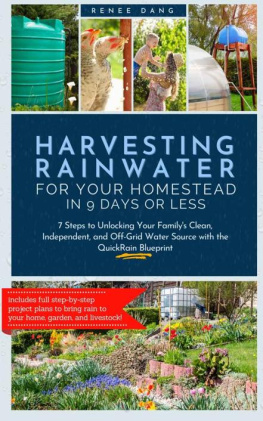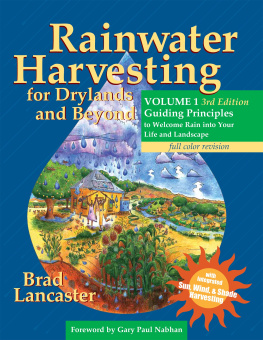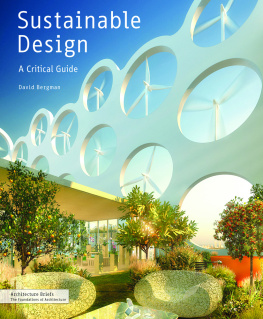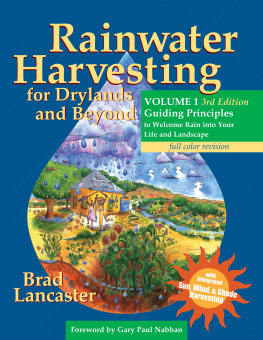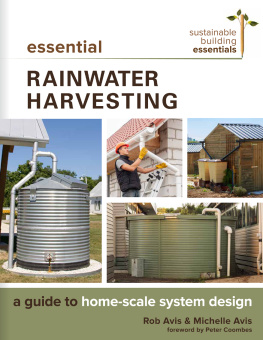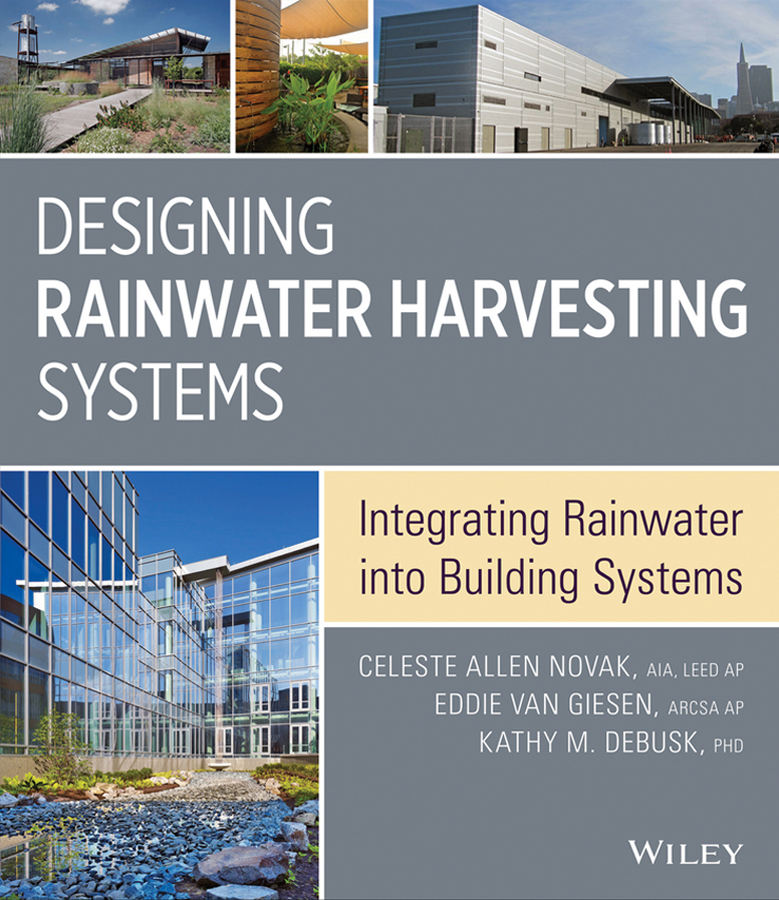
Contents
List of Illustrations
List of Tables
Pages
Guide
DESIGNING RAINWATER HARVESTING SYSTEMS
Integrating Rainwater into Building Systems
Celeste Allen Novak, FAIA, LEED AP
G. Edward Van Giesen, MLA, ARCSA AP
Kathy M. DeBusk, PhD, PE
Cover Design: Michael Rutkowski
Cover Photography: Top left: Lake|Flato Architects; Top middle: Vivian Van Giesen;
Top right: KMD ARCHITECTS + PLA, a Joint Venture; Bottom: Alan Karchmer, Courtesy of HOK
Copyright 2014 by John Wiley & Sons, Inc. All rights reserved
Published by John Wiley & Sons, Inc., Hoboken, New Jersey
Published simultaneously in Canada
No part of this publication may be reproduced, stored in a retrieval system, or transmitted in any form or by any means, electronic, mechanical, photocopying, recording, scanning, or otherwise, except as permitted under Section 107 or 108 of the 1976 United States Copyright Act, without either the prior written permission of the Publisher, or authorization through payment of the appropriate per-copy fee to the Copyright Clearance Center, 222 Rosewood Drive, Danvers, MA 01923, (978) 750-8400, fax (978) 646-8600, or on the web at www.copyright.com. Requests to the Publisher for permission should be addressed to the Permissions Department, John Wiley & Sons, Inc., 111 River Street, Hoboken, NJ 07030, (201) 748-6011, fax (201) 748-6008, or online at www.wiley.com/go/permissions.
Limit of Liability/Disclaimer of Warranty: While the publisher and author have used their best efforts in preparing this book, they make no representations or warranties with the respect to the accuracy or completeness of the contents of this book and specifically disclaim any implied warranties of merchantability or fitness for a particular purpose. No warranty may be created or extended by sales representatives or written sales materials. The advice and strategies contained herein may not be suitable for your situation. You should consult with a professional where appropriate. Neither the publisher nor the author shall be liable for damages arising herefrom.
For general information about our other products and services, please contact our Customer Care Department within the United States at (800) 762-2974, outside the United States at (317) 572-3993 or fax (317) 572-4002.
Wiley publishes in a variety of print and electronic formats and by print-on-demand. Some material included with standard print versions of this book may not be included in e-books or in print-on-demand. If this book refers to media such as a CD or DVD that is not included in the version you purchased, you may download this material at http://booksupport.wiley.com. For more information about Wiley products, visit www.wiley.com.
Library of Congress Cataloging-in-Publication Data:
Novak, Celeste Allen.
Designing rainwater harvesting systems: integrating rainwater into building systems / Celeste Allen Novak, FAIA, LEED AP, Eddie Van Giesen, ARCSA AP, Kathy M. DeBusk, PhD.
pages cm
Includes index.
ISBN 978-1-118-41047-9 (hardback); 978-1-118-42188-8 (ebk); 978-1-118-41786-7 (ebk)
1. Water harvesting. 2. Sustainable buildingsDesign and construction. 3. CisternsDesign and construction. 4. Sustainable architecture. I. Van Giesen, Eddie. II. DeBusk, Kathy M. III. Title.
TD418.N68 2014
628.1'42dc23
2013038062
Preface
G. EDWARD (EDDIE) VAN GIESEN
August 2013
After receiving my Masters in Landscape Architecture from the University of Georgia in 1995, I worked as a self-employed design/build landscape and general contractor and homebuilder in Athens, Georgia. I always incorporated green building practices, and received local sustainable building awards, but I knew that I could do more.
In 2007, we were all on the edge of the deepest economic recession that any of us could remember. I had an eerie suspicion that the housing boom was resting on a foundation of loose sand. By the end of the summer, homebuilding, as I knew it, was over. The profession that I had enjoyed for ten-plus years was not there anymore. I was forty-six years old and suddenly out of business.
At the same time, along with the economic recession, Georgia and much of the Southeastern United States was in the grip of an extreme drought. Due to the States increasing population, the effects of this drought were significantly amplified. Either we were all going to have to find other sources of water for the region or we would be increasingly vulnerable to water scarcity.
I did a lot of soul-searching in those months. I reflected on a trip made to Northern California in 2001, and a workshop I attended on rainwater harvesting. I read a few books on the subject, but little did I know that in only six years I would embark on the greatest adventure of my life.
I discovered that rainwater harvesting could be an answer to our water woes. It was a no-brainer. Rain falls on the roof; it is collected and utilized. Simple, easy, and sensible. Shortly thereafter, I stumbled upon the American Rainwater Catchment Systems Association (ARCSA). Through ARCSA I came to know people who had experience and generously shared their knowledge. I did not need to reinvent the wheel.
I began to install systems on a small scale and eventually worked with a company in North Carolina. By 2010, that company was bought by Watts and I joined them as the public policy director. Later I became the National Sales Manager and through my travels, I have had the opportunity to see the bigger picture. There is an enormous potential yet to be realized. Two things became abundantly clear: (1) education is essential for all the parties involved in these systems, and (2) plumbing codes need to be developed so that the industry can have a foundation upon which to build.
The opportunity to educate the design community through this book resonated with me when I was approached to be a co-author. It was a chance to establish and reinforce the fundamental principles of rainwater collection, as well as illuminate the connections between water policies, codes/regulations, and new and existing technologies.
Everyone involvedarchitects, engineers, landscape architects, mechanical contractors, manufacturers, suppliers, policy makers, code officials, and othersneeds to see the importance of their respective roles as part of the practice of wise use of rainwater. It is my sincere hope that this collaborative effort will contribute to an increase in awareness and implementation of successful rainwater harvesting systems.
KATHY DEBUSK
August 2013
It was during a canoe trip along the James River near Richmond, Virginia, that I discovered my true calling in life: stormwater management. While paddling past the heart of downtown Richmond one summer, my father and I were caught in a surprise thunderstorm. The short, yet intense, storm resulted in the discharge of urban runoff into the river just upstream of where we were floating. Not only did this water have a foul odor, but it was filled with a tremendous amount of trash and debris. Then and there, I decided that I wanted to become a part of the effort to decrease the impact of urban runoff on valuable water resources such as the James River.
It wasnt until many years later, after a bachelors and masters degree in engineering at Virginia Tech, that I was exposed to rainwater harvesting. One of my first design projects as an Extension Associate at North Carolina State University was a rainwater harvesting system for an animal shelter in Craven County. It was love at first sight. I continued to design and research rainwater harvesting systems throughout my stay at NCSU, and even made rainwater harvesting the focus of my doctoral research.
Next page

